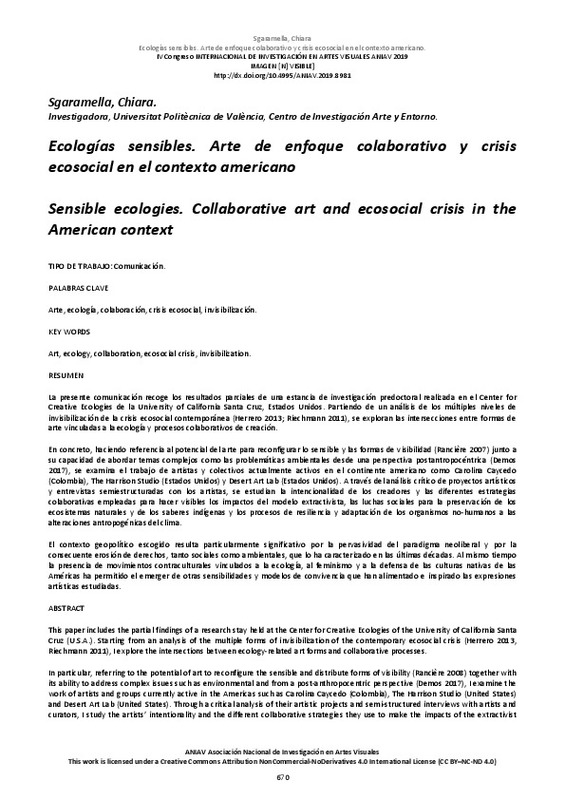JavaScript is disabled for your browser. Some features of this site may not work without it.
Buscar en RiuNet
Listar
Mi cuenta
Estadísticas
Ayuda RiuNet
Admin. UPV
Ecologías sensibles. Arte de enfoque colaborativo y crisis ecosocial en el contexto americano
Mostrar el registro sencillo del ítem
Ficheros en el ítem
| dc.contributor.author | Sgaramella, Chiara
|
es_ES |
| dc.date.accessioned | 2019-10-16T07:04:43Z | |
| dc.date.available | 2019-10-16T07:04:43Z | |
| dc.date.issued | 2019-09-10 | |
| dc.identifier.isbn | 9788490487662 | |
| dc.identifier.uri | http://hdl.handle.net/10251/128542 | |
| dc.description.abstract | [ES] La presente comunicación recoge los resultados parciales de una estancia de investigación predoctoral realizada en el Center for Creative Ecologies de la University of California Santa Cruz, Estados Unidos. Partiendo de un análisis de los múltiples niveles de invisibilización de la crisis ecosocial contemporánea (Herrero 2013; Riechmann 2011), se exploran las intersecciones entre formas de arte vinculadas a la ecología y procesos colaborativos de creación. En concreto, haciendo referencia al potencial del arte para reconfigurar lo sensible y las formas de visibilidad (Rancière 2007) junto a su capacidad de abordar temas complejos como las problemáticas ambientales desde una perspectiva postantropocéntrica (Demos 2017), se examina el trabajo de artistas y colectivos actualmente activos en el continente americano como Carolina Caycedo (Colombia), The Harrison Studio (Estados Unidos) y Desert Art Lab (Estados Unidos). A través del análisis crítico de proyectos artísticos y entrevistas semiestructuradas con los artistas, se estudian la intencionalidad de los creadores y las diferentes estrategias colaborativas empleadas para hacer visibles los impactos del modelo extractivista, las luchas sociales para la preservación de los ecosistemas naturales y de los saberes indígenas y los procesos de resiliencia y adaptación de los organismos no-humanos a las alteraciones antropogénicas del clima. El contexto geopolítico escogido resulta particularmente significativo por la pervasividad del paradigma neoliberal y por la consecuente erosión de derechos, tanto sociales como ambientales, que lo ha caracterizado en las últimas décadas. Al mismo tiempo la presencia de movimientos contraculturales vinculados a la ecología, al feminismo y a la defensa de las culturas nativas de las Américas ha permitido el emerger de otras sensibilidades y modelos de convivencia que han alimentado e inspirado las expresiones artísticas estudiadas. | es_ES |
| dc.description.abstract | [EN] This paper includes the partial findings of a research stay held at the Center for Creative Ecologies of the University of California Santa Cruz (U.S.A.). Starting from an analysis of the multiple forms of invisibilization of the contemporary ecosocial crisis (Herrero 2013, Riechmann 2011), I explore the intersections between ecology-related art forms and collaborative processes. In particular, referring to the potential of art to reconfigure the sensible and distribute forms of visibility (Rancière 2008) together with its ability to address complex issues such as environmental and from a post-anthropocentric perspective (Demos 2017), I examine the work of artists and groups currently active in the Americas such as Carolina Caycedo (Colombia), The Harrison Studio (United States) and Desert Art Lab (United States). Through a critical analysis of their artistic projects and semi-structured interviews with artists and curators, I study the artists’ intentionality and the different collaborative strategies they use to make the impacts of the extractivist model visible together with the social struggles for the preservation of ecosystems and indigenous knowledge systems, and the processes of resilience and adaptation of non-human organisms to anthropogenic climate change. The chosen geopolitical context is especially significant because of the pervasiveness of the neoliberal paradigm that has characterized it in recent decades, with the consequent erosion of both social and environmental rights. At the same time, the presence of countercultural movements linked to ecology, feminism and the defense of the native cultures of the Americas has allowed the emergence of alternative discourses and models of coexistence that have nurtured and inspired the artistic manifestations our study revolves around. | es_ES |
| dc.format.extent | 7 | es_ES |
| dc.language | Español | es_ES |
| dc.publisher | Editorial Universitat Politècnica de València | es_ES |
| dc.relation.ispartof | IV Congreso Internacional de investigación en artes visuales: ANIAV 2019 Imagen [N] visible | es_ES |
| dc.rights | Reconocimiento - No comercial - Sin obra derivada (by-nc-nd) | es_ES |
| dc.subject | Arte | es_ES |
| dc.subject | Producción artística | es_ES |
| dc.subject | Estética | es_ES |
| dc.subject | Teoría del arte | es_ES |
| dc.subject | Gestión cultural | es_ES |
| dc.subject | Educación artística | es_ES |
| dc.subject | Investigación artística | es_ES |
| dc.subject | Ecología | es_ES |
| dc.subject | Colaboración | es_ES |
| dc.subject | Crisis ecosocial | es_ES |
| dc.subject | Invisibilización | es_ES |
| dc.title | Ecologías sensibles. Arte de enfoque colaborativo y crisis ecosocial en el contexto americano | es_ES |
| dc.title.alternative | Sensible ecologies. Collaborative art and ecosocial crisis in the American context | es_ES |
| dc.type | Capítulo de libro | es_ES |
| dc.type | Comunicación en congreso | es_ES |
| dc.identifier.doi | 10.4995/ANIAV2019.2019.8981 | |
| dc.rights.accessRights | Abierto | es_ES |
| dc.description.bibliographicCitation | Sgaramella, C. (2019). Ecologías sensibles. Arte de enfoque colaborativo y crisis ecosocial en el contexto americano. En IV Congreso Internacional de investigación en artes visuales: ANIAV 2019 Imagen [N] visible. Editorial Universitat Politècnica de València. 670-676. https://doi.org/10.4995/ANIAV2019.2019.8981 | es_ES |
| dc.description.accrualMethod | OCS | es_ES |
| dc.relation.conferencename | IV Congreso Internacional de Investigación en Artes Visuales. ANIAV 2019. Imagen [N] Visible | es_ES |
| dc.relation.conferencedate | Julio 03-05, 2019 | es_ES |
| dc.relation.conferenceplace | Valencia, Spain | es_ES |
| dc.relation.publisherversion | http://ocs.editorial.upv.es/index.php/ANIAV/ANIAV2019/paper/view/8981 | es_ES |
| dc.description.upvformatpinicio | 670 | es_ES |
| dc.description.upvformatpfin | 676 | es_ES |
| dc.type.version | info:eu-repo/semantics/publishedVersion | es_ES |
| dc.relation.pasarela | OCS\8981 | es_ES |








